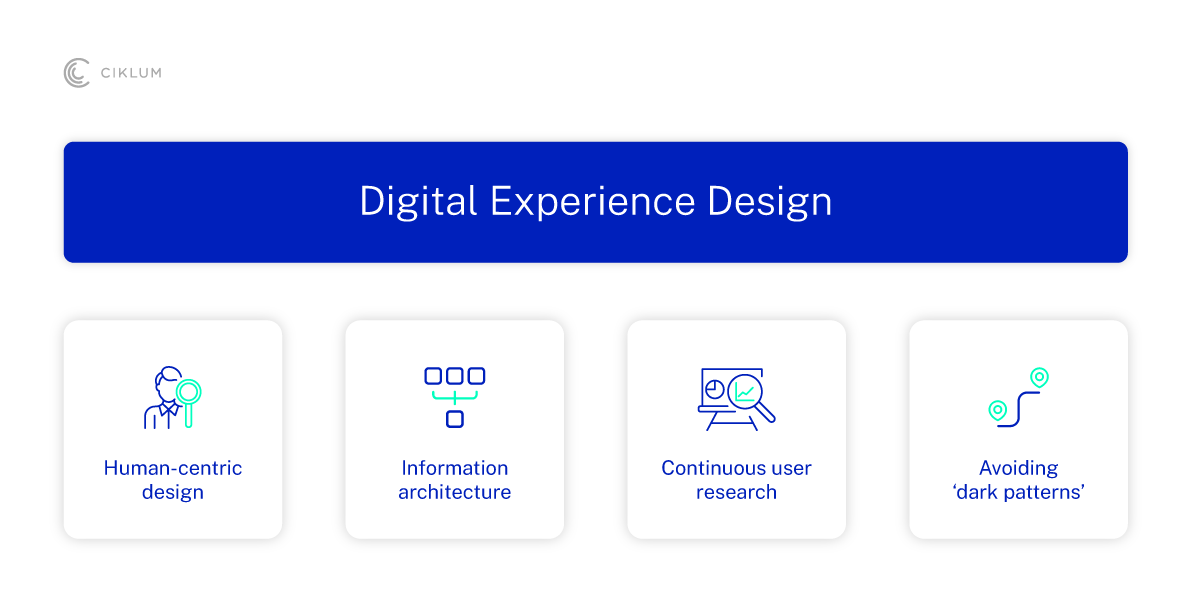- Why Digital Experience Design Matters: Key Strategies and Best Practices
- What is Digital Experience Design?
- Why is Digital Experience Design Important?
- The Foundations of Digital Experience Design
- The Digital Experience Design Process
- Best Practices for Digital Experience Design
- In Summary: Future Trends in Digital Experience Design
Key takeaways:
- Digital experience design is vital for ensuring customer retention amid high churn rates
- User research and fast iterative approach are key parts of the strategy
- Users want ease of use, transparency and ethical design elements
- New technologies will make digital experience design even more important in the future
Why Digital Experience Design Matters: Key Strategies and Best Practices
When it comes to user activity online, digital experience design makes a bigger difference than ever before. When users are able to shop around easily, whether it’s purchasing from a different brand or choosing one app over another, making a lasting positive impact is absolutely vital.Linearity research has found that as many as 88% of consumers are less likely to return to a website if they’ve had a bad experience with it. And when you consider that 94% of first impressions on a website are design-related, it’s clear that digital experience design has a huge influence on the success or failure of any online presence.
In this blog, we’ll explore digital experience design in detail, including how it works, the foundations behind it, and how best to apply it in practice within your organization.
What is Digital Experience Design?
Digital experience design refers to the creation of experiences across an entire digital footprint that are considered, coordinated, and that enhance interactions with the organization across every touchpoint. Good digital experience design will generally bring together three interconnected factors: User Interface (UI)
User Interface (UI)
The points of interaction between a user and the brand, taking into account all visual design aspects, including content, typography, fonts, images, videos, graphics and more. User Experience (UX)
User Experience (UX)
The ways in which digital footprints are optimized, with the aim of maximizing user satisfaction. This means addressing usability, accessibility and enjoyability, and removing any barriers to users getting the fast, stress-free and intuitive experiences they want. Customer Experience (CX)
Customer Experience (CX)
Customer experience combines UI and UX, but ultimately takes a more overarching view around how customers use a website or app. In particular, it focuses on the whole journey towards the intended outcome, whether that’s a purchase, completing a sign-up form, or accessing a target web page.Why is Digital Experience Design Important?
Digital experience design has a crucial role to play in enticing users to engage with digital content, for them to do so for extended periods of time, and to come back and do so again in the future. According to SharpSheets, 73% of mobile app users churn within 90 days, so trying to retain and attract users should be a constant effort.When digital experience design is done right, it can support:
Stronger user engagement and retention: when users enjoy the experience, they are far more likely to explore the website or app further, and build an emotional connection.
Deeper brand loyalty and customer satisfaction: connected to the first point, that connection makes it more likely that a user will come back to the brand in the future instead of opting for a competitor.
Increased conversion rates: more engagement and more loyalty means greater conversions, which support a stronger bottom line in the long term.
The Foundations of Digital Experience Design
Behind the three key concepts that drive digital experience designs are a range of principles that encourage best practice and drive the best possible result. These include:
Human-centered design: ensuring that designs, planning and decision-making is always focused around the expectations, desires and pain points of the user, rather than business objectives or the bottom line.
Information architecture: ensuring that content is structured and organized properly, so that it is easy and clear for users to navigate their way through a website or app, and reach the intended objective.
Continuous user research: working to understand user sentiment and preferences through interviews, surveys, usability testing and other methods - especially as these preferences constantly evolve. This allows the right design decisions to be made, based on hard evidence rather than assumptions.
Fast iterative approach: implementing rapid prototyping and agile methodologies to quickly test ideas, gather feedback, and refine designs in short cycles. This allows for greater flexibility, responsiveness to changing requirements, and faster time-to-market for new features or improvements.
Avoiding ‘dark patterns’: these tactics that manipulate users into the intended actions, even when they didn’t plan to do so, can be extremely powerful in driving business success. However, they are widely disliked by users, who want to feel in control of their own online activity, so avoiding them is vital for fostering trust, and by extension, brand loyalty.

The Digital Experience Design Process
On a practical level, there are four key stages in the digital experience design process, which should always be tackled in the following order:
![]() Strategy and planning:
Strategy and planning:
Developing a clear strategy around what should be designed and how, in the context of the overarching business objectives and outcomes.
![]() User research and analysis:
User research and analysis:
Gaining a clear and detailed understanding of user needs, and the current demands of the marketplace, to steer design decisions in the right direction.
![]() Design implementation:
Design implementation:
Creating digital elements, based on the design principles and user sentiment established, to deliver on user expectations and drive towards the business objectives.
![]() User testing and optimization:
User testing and optimization:
Leveraging user feedback and evolving market and consumer conditions to adopt continuous improvement and ensure engagement is always maximized.
Best Practices for Digital Experience Design
Within those practical steps, there are also some good practices to follow that can help make a digital experience design process as successful as possible, such as:Focusing on customer needs: understanding and addressing the specific goals, needs, or problems of the user should be at the core of every design decision; this ensures the digital experience delivers genuine value and relevance.
In Summary: Future Trends in Digital Experience Design
Linearity has found that improved UX design can increase your website’s conversion rate by as much as 200%, underlining the value of maximizing its potential. This will be especially important in the future, when AI-driven personalization will become pivotal in delivering the customized experiences users are looking for.At the same time, this personalization will need to be connected to omnichannel strategies and sustainable design processes, so that users feel that they are getting experiences that support their preferences, and the needs of the world at large.
If you feel you need help exploring the full potential of digital experience design, then Ciklum’s experienced experts have all the tools and support you need. Talk to us today to discuss your specifics.
Blogs


































